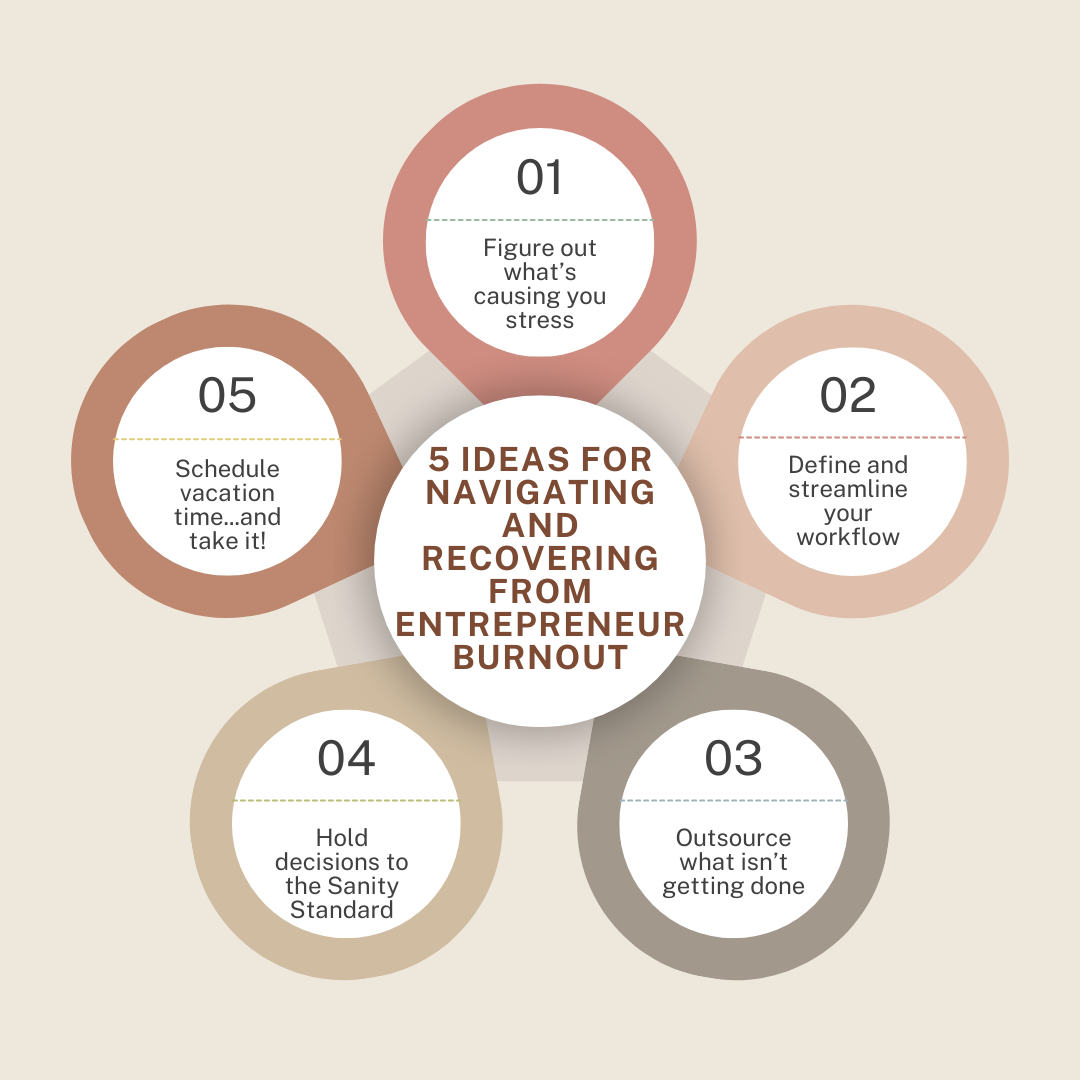Last week we talked about some of the common signs and symptoms of entrepreneur burnout. I’ve been recognizing those signs in myself and realizing that, “Yep, I think that’s what I’m going through.” If you’re the same way, then you’re probably asking, “Now what?”
Burnout can feel really overwhelming and scary, and as someone in the middle of it, I’m not going to pretend I’m some kind of expert on getting out. However, as I’ve been researching and learning more about burnout, I’ve come across some ideas that I want to implement so that I can move through (and hopefully overcome) the small business owner burnout I’m experiencing.
These 5 ideas for navigating and recovering from entrepreneur burnout are helping me to feel a little more in control and like maybe there is a light at the end of the tunnel after all. I hope they do the same for you! More importantly, I hope they spark ideas of your own and give you confidence that you can find your way out of this stage in a way that works for you.
Here’s How I’m Trying to Navigate Burnout:
Make a List of What’s Causing You Stress
It doesn’t have to be business related, and it doesn’t have to be big. Stress doesn’t really compartmentalize. If it affects one area of your life, it’s going to start affecting other areas too. So jot down everything that’s been bothering you lately.
Maybe replying to your emails and text messages feels daunting. Or you’ve felt too tired to exercise and you know you should. Maybe there’s a project coming up that seems big and overwhelming, you never know what’s for dinner, or you keep forgetting to run that one errand.
Even really little stressors can pile up and start to influence how you feel about your business. Once you have them all written down, you can start analyzing what you can change to make things more manageable.
Here’s an example of one thing I identified and how I’m handling it:
Stressor: Notifications on my phone. Seriously, they’re coming up constantly. And some of them…just…why? Someone I follow on Facebook posted something new, which doesn’t particularly matter to me, since I follow several people and there’s bound to be a new post at just about any minute of the day. But suddenly I have this alarming red exclamation point on my Facebook icon, and it’s like a fire I have to put out. Aargh!
Simple, short-term solution: Extend my do not disturb hours and keep my phone on silent. (Just doing this has already made a noticeable difference.)
Ideas for long-term solution: Clean up my phone to remove any apps I don’t use regularly. Turn off as many notifications as possible in my settings. Establish a particular time of my workday when I check emails, texts, voicemail, and social media.
Some things on your list might not have a viable solution right now. That’s okay. It’s not possible to remove all stress from your life. But it is possible to make some life adjustments and tweaks to your day that can reduce or remove some of the stressors and make life easier to manage.
Define Your Workflow
As I mentioned in my previous post, small business owner burnout has really done a number on my executive functioning. So things that used to feel automatic…don’t anymore.
To keep myself on track, I’ve decided to write out my monthly workflow in checklist form. My basic to-do list stays pretty consistent month to month, and I’m already in the habit of doing a quick planning session at the beginning of each month, so I’m hoping this will help me to:
- Make sure I’m getting everything done that I need to
- Stop stressing about stuff that’s not on the to-do list and is just an extra
- Free up my mental energy so that I’m not constantly wondering what I’ve done and what I still have to do
I think I also need to write out a checklist for my client workflows so that I don’t have to worry about remembering all the little details: Adding alt text to images, writing a meta description for each post, or doing requested extras like adding their signature at the bottom of the post. Every client is a little different, and while I’m generally pretty good at keeping all the different needs straight, I think it would free up some of my brainpower to have it written down so I know exactly what to do without having to think about it.
I’m a big fan of the checklist because it allows for flexibility and helps me see exactly what I’m accomplishing. But if a calendar or planner works better for you, do that! The point is to get your business to-do list out of your head and somewhere physical where you can see it and have a clear idea of what needs to be done and what is no longer a worry.
Outsource Stuff That Isn’t Getting Done
I’ve been wanting to redesign my website for a while now. It’s been on my mind almost constantly.
And it’s gotten exactly nowhere.
So, rather than let it continue to percolate in my brain, never becoming a reality and causing me a lot of stress, I’ve decided to outsource it.
Honestly, just making this decision has lifted a weight from my mind. I’ve already met with a web designer to talk details, and I’m excited to hand this task over to someone who knows what they’re doing and, crucially, will actually do it!
If you have work tasks you feel are important, but that just aren’t getting done, have someone else handle those things. You can outsource just about anything, and it can really help both your business and your mental health if you have the resources to do it. (If money is a resource that’s in short supply right now, it might be worth it to explore trading services. I’ve done this successfully in the past, trading blog posts for headshots, and it’s worked out nicely for both parties.)
Hold Decisions to the Sanity Standard
I have a hard time making decisions at the best of times. I overthink. I go back and forth. I second-guess myself. It takes forever.
And when I’m feeling burned out? Every decision is overwhelming. It can take me half an hour to pick out a shirt in the morning, so when I’m faced with something like, “Which hosting platform should I use to design my new website?” it makes me want to crawl back under the covers and never come out.
Which is why navigating burnout has involved a slight lowering of my standards when it comes to decision-making.
Rather than ask myself, “Is this the right decision?” or “Is this the best choice?” I’m just asking, “Is this an insane decision?”
For example: Objectively deciding which web hosting platform is the best is impossible, since they all have their pros and cons. The question of which is the right one for me is almost as tough. But if I’m waffling between Wix, WordPress, and Squarespace and think to myself, “I’m kind of leaning towards Wix…” it’s basically the same as making a decision.
Because: Is building my website on Wix an insane decision?
No. I know people with successful sites on all three of these platforms. I know my decision can work. So I can move forward. I might still have some qualms and wonder if I should have done Squarespace after all (which also would be a not insane decision) but I’m no longer paralyzed.
Basically, a website that’s built is better than one that still exists only in my mind. And nobody’s going to say to me, “Wait, you built your website through who? Are you insane?” My choice is sane and reasonable, and right now, that’s good enough.
Schedule Vacation Time
We’ve probably all had the experience of getting sick and completely ignoring our symptoms. Instead of taking it easy we force ourselves to push through. This approach never ends up working well for me. It often makes my symptoms worse, and always means it will take me longer to get back to normal.
It’s the same with burnout. Rest is an important part of the recovery process. And by rest I mean legitimate rest, not using your day off to catch up on the housework. Treat it like a vacation, whether it’s a day or a week, and use it to do something you really enjoy and that helps you feel rejuvenated.
This is something I’m hoping I can figure out! I thought I was doing pretty good because I schedule in time for myself each week. But…here I am, feeling burned out. What’s up with that?
Well, I’m not entirely sure. But I’ve been thinking about it, and here are some possibilities:
I realized that even though I was setting aside regular time as part of my weekly workflow, I hadn’t taken a larger chunk of time off in quite a while. And maybe I need a longer stretch occasionally to really decompress.
I’ve also gotten into a rut with how I use my time off. I nearly always do the same thing. This is probably because I’m not thinking about it throughout the week, and when my scheduled relax time comes around I’m tired and don’t have much energy to think about how I want to use it. So I default to a tried-and-true activity instead of getting creative. So guess what? On my next day off I’m going to take some time to brainstorm a list of ideas for ways I can use my mini staycations. That way, the ideas are all there and I just have to choose one.
And…yes, I have sometimes used my time off to just do something easy and mindless, or something I think I should do, rather than something that will actually lift my spirits and help me feel fulfilled.
See, I told you I’m not an expert. I’m still learning too!
How Do You Navigate Burnout?
I hope these 5 things I’ve been learning about navigating and recovering from entrepreneur burnout are helpful to you! I’m hoping that by implementing these things I’ll be able to stay on top of the essentials while I navigate this extremely tough stage of business ownership. And as these strategies become more natural, maybe I can create a more sustainable approach and avoid burnout in the future! More about that in part three.
What about you? Are you in small business owner burnout right now? I’d really like to hear what you’re learning and trying out. Or maybe this is a been-there-done-that experience for you. If you’ve successfully gotten out of entrepreneurial burnout, I know I’m not the only one who would appreciate your hard-won wisdom! Please feel free to share your favorite tools and strategies for navigating and recovering from burnout. I look forward to learning from you!



